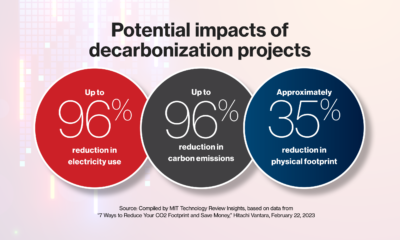Tech
Getting value from your data shouldn’t be this hard
Published
3 years agoon
By
Drew Simpson
The potential impact of the ongoing worldwide data explosion continues to excite the imagination. A 2018 report estimated that every second of every day, every person produces 1.7 MB of data on average—and annual data creation has more than doubled since then and is projected to more than double again by 2025. A report from McKinsey Global Institute estimates that skillful uses of big data could generate an additional $3 trillion in economic activity, enabling applications as diverse as self-driving cars, personalized health care, and traceable food supply chains.
But adding all this data to the system is also creating confusion about how to find it, use it, manage it, and legally, securely, and efficiently share it. Where did a certain dataset come from? Who owns what? Who’s allowed to see certain things? Where does it reside? Can it be shared? Can it be sold? Can people see how it was used?
As data’s applications grow and become more ubiquitous, producers, consumers, and owners and stewards of data are finding that they don’t have a playbook to follow. Consumers want to connect to data they trust so they can make the best possible decisions. Producers need tools to share their data safely with those who need it. But technology platforms fall short, and there are no real common sources of truth to connect both sides.
How do we find data? When should we move it?
In a perfect world, data would flow freely like a utility accessible to all. It could be packaged up and sold like raw materials. It could be viewed easily, without complications, by anyone authorized to see it. Its origins and movements could be tracked, removing any concerns about nefarious uses somewhere along the line.
Today’s world, of course, does not operate this way. The massive data explosion has created a long list of issues and opportunities that make it tricky to share chunks of information.
With data being created nearly everywhere within and outside of an organization, the first challenge is identifying what is being gathered and how to organize it so it can be found.
A lack of transparency and sovereignty over stored and processed data and infrastructure opens up trust issues. Today, moving data to centralized locations from multiple technology stacks is expensive and inefficient. The absence of open metadata standards and widely accessible application programming interfaces can make it hard to access and consume data. The presence of sector-specific data ontologies can make it hard for people outside the sector to benefit from new sources of data. Multiple stakeholders and difficulty accessing existing data services can make it hard to share without a governance model.
Europe is taking the lead
Despite the issues, data-sharing projects are being undertaken on a grand scale. One that’s backed by the European Union and a nonprofit group is creating an interoperable data exchange called Gaia-X, where businesses can share data under the protection of strict European data privacy laws. The exchange is envisioned as a vessel to share data across industries and a repository for information about data services around artificial intelligence (AI), analytics, and the internet of things.
Hewlett Packard Enterprise recently announced a solution framework to support companies, service providers, and public organizations’ participation in Gaia-X. The dataspaces platform, which is currently in development and based on open standards and cloud native, democratizes access to data, data analytics, and AI by making them more accessible to domain experts and common users. It provides a place where experts from domain areas can more easily identify trustworthy datasets and securely perform analytics on operational data—without always requiring the costly movement of data to centralized locations.
By using this framework to integrate complex data sources across IT landscapes, enterprises will be able to provide data transparency at scale, so everyone—whether a data scientist or not—knows what data they have, how to access it, and how to use it in real time.
Data-sharing initiatives are also on the top of enterprises’ agendas. One important priority enterprises face is the vetting of data that’s being used to train internal AI and machine learning models. AI and machine learning are already being used widely in enterprises and industry to drive ongoing improvements in everything from product development to recruiting to manufacturing. And we’re just getting started. IDC projects the global AI market will grow from $328 billion in 2021 to $554 billion in 2025.
To unlock AI’s true potential, governments and enterprises need to better understand the collective legacy of all the data that is driving these models. How do AI models make their decisions? Do they have bias? Are they trustworthy? Have untrustworthy individuals been able to access or change the data that an enterprise has trained its model against? Connecting data producers to data consumers more transparently and with greater efficiency can help answer some of these questions.
Building data maturity
Enterprises aren’t going to solve how to unlock all of their data overnight. But they can prepare themselves to take advantage of technologies and management concepts that help to create a data-sharing mentality. They can ensure that they’re developing the maturity to consume or share data strategically and effectively rather than doing it on an ad hoc basis.
Data producers can prepare for wider distribution of data by taking a series of steps. They need to understand where their data is and understand how they’re collecting it. Then, they need to make sure the people who consume the data have the ability to access the right sets of data at the right times. That’s the starting point.
Then comes the harder part. If a data producer has consumers—which can be inside or outside the organization—they have to connect to the data. That’s both an organizational and a technology challenge. Many organizations want governance over data sharing with other organizations. The democratization of data—at least being able to find it across organizations—is an organizational maturity issue. How do they handle that?
Companies that contribute to the auto industry actively share data with vendors, partners, and subcontractors. It takes a lot of parts—and a lot of coordination—to assemble a car. Partners readily share information on everything from engines to tires to web-enabled repair channels. Automotive dataspaces can serve upwards of 10,000 vendors. But in other industries, it might be more insular. Some large companies might not want to share sensitive information even within their own network of business units.
Creating a data mentality
Companies on either side of the consumer-producer continuum can advance their data-sharing mentality by asking themselves these strategic questions:
- If enterprises are building AI and machine learning solutions, where are the teams getting their data? How are they connecting to that data? And how do they track that history to ensure trustworthiness and provenance of data?
- If data has value to others, what is the monetization path the team is taking today to expand on that value, and how will it be governed?
- If a company is already exchanging or monetizing data, can it authorize a broader set of services on multiple platforms—on premises and in the cloud?
- For organizations that need to share data with vendors, how is the coordination of those vendors to the same datasets and updates getting done today?
- Do producers want to replicate their data or force people to bring models to them? Datasets might be so large that they can’t be replicated. Should a company host software developers on its platform where its data is and move the models in and out?
- How can workers in a department that consumes data influence the practices of the upstream data producers within their organization?
Taking action
The data revolution is creating business opportunities—along with plenty of confusion about how to search for, collect, manage, and gain insights from that data in a strategic way. Data producers and data consumers are becoming more disconnected with each other. HPE is building a platform supporting both on-premises and public cloud, using open source as the foundation and solutions like HPE Ezmeral Software Platform to provide the common ground both sides need to make the data revolution work for them.
Read the original article on Enterprise.nxt.
This content was produced by Hewlett Packard Enterprise. It was not written by MIT Technology Review’s editorial staff.
You may like
-


Why the EU AI Act was so hard to agree on
-


Sustainability starts with the data center
-


Meta is giving researchers more access to Facebook and Instagram data
-


The Download: are we alone, and private military data for sale
-


It’s shockingly easy to buy sensitive data about US military personnel
-


The Download: military personnel data for sale, and AI watermarking
Tech
The hunter-gatherer groups at the heart of a microbiome gold rush
Published
5 months agoon
12/19/2023By
Drew Simpson
The first step to finding out is to catalogue what microbes we might have lost. To get as close to ancient microbiomes as possible, microbiologists have begun studying multiple Indigenous groups. Two have received the most attention: the Yanomami of the Amazon rainforest and the Hadza, in northern Tanzania.
Researchers have made some startling discoveries already. A study by Sonnenburg and his colleagues, published in July, found that the gut microbiomes of the Hadza appear to include bugs that aren’t seen elsewhere—around 20% of the microbe genomes identified had not been recorded in a global catalogue of over 200,000 such genomes. The researchers found 8.4 million protein families in the guts of the 167 Hadza people they studied. Over half of them had not previously been identified in the human gut.
Plenty of other studies published in the last decade or so have helped build a picture of how the diets and lifestyles of hunter-gatherer societies influence the microbiome, and scientists have speculated on what this means for those living in more industrialized societies. But these revelations have come at a price.
A changing way of life
The Hadza people hunt wild animals and forage for fruit and honey. “We still live the ancient way of life, with arrows and old knives,” says Mangola, who works with the Olanakwe Community Fund to support education and economic projects for the Hadza. Hunters seek out food in the bush, which might include baboons, vervet monkeys, guinea fowl, kudu, porcupines, or dik-dik. Gatherers collect fruits, vegetables, and honey.
Mangola, who has met with multiple scientists over the years and participated in many research projects, has witnessed firsthand the impact of such research on his community. Much of it has been positive. But not all researchers act thoughtfully and ethically, he says, and some have exploited or harmed the community.
One enduring problem, says Mangola, is that scientists have tended to come and study the Hadza without properly explaining their research or their results. They arrive from Europe or the US, accompanied by guides, and collect feces, blood, hair, and other biological samples. Often, the people giving up these samples don’t know what they will be used for, says Mangola. Scientists get their results and publish them without returning to share them. “You tell the world [what you’ve discovered]—why can’t you come back to Tanzania to tell the Hadza?” asks Mangola. “It would bring meaning and excitement to the community,” he says.
Some scientists have talked about the Hadza as if they were living fossils, says Alyssa Crittenden, a nutritional anthropologist and biologist at the University of Nevada in Las Vegas, who has been studying and working with the Hadza for the last two decades.
The Hadza have been described as being “locked in time,” she adds, but characterizations like that don’t reflect reality. She has made many trips to Tanzania and seen for herself how life has changed. Tourists flock to the region. Roads have been built. Charities have helped the Hadza secure land rights. Mangola went abroad for his education: he has a law degree and a master’s from the Indigenous Peoples Law and Policy program at the University of Arizona.
Tech
The Download: a microbiome gold rush, and Eric Schmidt’s election misinformation plan
Published
5 months agoon
12/18/2023By
Drew Simpson
Over the last couple of decades, scientists have come to realize just how important the microbes that crawl all over us are to our health. But some believe our microbiomes are in crisis—casualties of an increasingly sanitized way of life. Disturbances in the collections of microbes we host have been associated with a whole host of diseases, ranging from arthritis to Alzheimer’s.
Some might not be completely gone, though. Scientists believe many might still be hiding inside the intestines of people who don’t live in the polluted, processed environment that most of the rest of us share. They’ve been studying the feces of people like the Yanomami, an Indigenous group in the Amazon, who appear to still have some of the microbes that other people have lost.
But there is a major catch: we don’t know whether those in hunter-gatherer societies really do have “healthier” microbiomes—and if they do, whether the benefits could be shared with others. At the same time, members of the communities being studied are concerned about the risk of what’s called biopiracy—taking natural resources from poorer countries for the benefit of wealthier ones. Read the full story.
—Jessica Hamzelou
Eric Schmidt has a 6-point plan for fighting election misinformation
—by Eric Schmidt, formerly the CEO of Google, and current cofounder of philanthropic initiative Schmidt Futures
The coming year will be one of seismic political shifts. Over 4 billion people will head to the polls in countries including the United States, Taiwan, India, and Indonesia, making 2024 the biggest election year in history.
Tech
Navigating a shifting customer-engagement landscape with generative AI
Published
5 months agoon
12/18/2023By
Drew Simpson
A strategic imperative
Generative AI’s ability to harness customer data in a highly sophisticated manner means enterprises are accelerating plans to invest in and leverage the technology’s capabilities. In a study titled “The Future of Enterprise Data & AI,” Corinium Intelligence and WNS Triange surveyed 100 global C-suite leaders and decision-makers specializing in AI, analytics, and data. Seventy-six percent of the respondents said that their organizations are already using or planning to use generative AI.
According to McKinsey, while generative AI will affect most business functions, “four of them will likely account for 75% of the total annual value it can deliver.” Among these are marketing and sales and customer operations. Yet, despite the technology’s benefits, many leaders are unsure about the right approach to take and mindful of the risks associated with large investments.
Mapping out a generative AI pathway
One of the first challenges organizations need to overcome is senior leadership alignment. “You need the necessary strategy; you need the ability to have the necessary buy-in of people,” says Ayer. “You need to make sure that you’ve got the right use case and business case for each one of them.” In other words, a clearly defined roadmap and precise business objectives are as crucial as understanding whether a process is amenable to the use of generative AI.
The implementation of a generative AI strategy can take time. According to Ayer, business leaders should maintain a realistic perspective on the duration required for formulating a strategy, conduct necessary training across various teams and functions, and identify the areas of value addition. And for any generative AI deployment to work seamlessly, the right data ecosystems must be in place.
Ayer cites WNS Triange’s collaboration with an insurer to create a claims process by leveraging generative AI. Thanks to the new technology, the insurer can immediately assess the severity of a vehicle’s damage from an accident and make a claims recommendation based on the unstructured data provided by the client. “Because this can be immediately assessed by a surveyor and they can reach a recommendation quickly, this instantly improves the insurer’s ability to satisfy their policyholders and reduce the claims processing time,” Ayer explains.
All that, however, would not be possible without data on past claims history, repair costs, transaction data, and other necessary data sets to extract clear value from generative AI analysis. “Be very clear about data sufficiency. Don’t jump into a program where eventually you realize you don’t have the necessary data,” Ayer says.
The benefits of third-party experience
Enterprises are increasingly aware that they must embrace generative AI, but knowing where to begin is another thing. “You start off wanting to make sure you don’t repeat mistakes other people have made,” says Ayer. An external provider can help organizations avoid those mistakes and leverage best practices and frameworks for testing and defining explainability and benchmarks for return on investment (ROI).
Using pre-built solutions by external partners can expedite time to market and increase a generative AI program’s value. These solutions can harness pre-built industry-specific generative AI platforms to accelerate deployment. “Generative AI programs can be extremely complicated,” Ayer points out. “There are a lot of infrastructure requirements, touch points with customers, and internal regulations. Organizations will also have to consider using pre-built solutions to accelerate speed to value. Third-party service providers bring the expertise of having an integrated approach to all these elements.”
